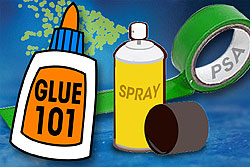You need to communicate clearly, and in
writing, with a consignment sales agreement to ensure the best chance
of building a positive experience that works for you and the shop owner. This means that you need to know the
terminology used and required in consignment agreements.
Meet the taxation requirements
Make sure you have complied with the legal requirements in
your jurisdiction for selling. In the
United States, for example, you need a tax identification number. In the United Kingdom, you do not need
anything other than your personal tax number, unless you are selling so much
that you are employing other people.
Written contract
You need more than a verbal agreement. Ask for their consignment agreement and take
it away to consider the terms. It is not
pushy to do this; the shop owner would do the same. If the gallery/shop does
not have a standard contract, you need to develop one and negotiate it with the
owner. The important elements are the
commission rate, payment terms and frequency, insurance, breakages & theft,
inventory arrangements.
Commission rate
A direct sale to the shop is normally marked up 100% of your
price plus taxes to give the retail price.
So, the commission taken should be less that than that. If the shop wants 50% commission, counter
with direct sale at that level of commission.
It would be exceptional circumstances only that 50% commission would be
acceptable to you. 30% - 40% is more
usual. The agreed rate should be written
in the contract.
Payment terms
How frequently will you be paid for the work sold? This needs to be included in the
agreement. Associated with this is
inventory.
Inventory
You need to provide an item and price list for the gallery
and one for yourself. It should state
the name of the parties at the head. It is essential to list the date
delivered, the number and description of the items. Each line of work needs to
have the item price to the gallery and the total price for each line. This list
gives the sums you expect to receive upon their sale. It is possible you will want to include, by
agreement, their commission and the
retail price, although the gallery may change the retail price at any time. If they want to reduce the price, that will
come from their commission. The price on
the consignment form is not to be reduced, even though they ask for it. If they
want to increase the price, they will keep the additional sums – in which case,
of course, you should be thinking about increasing your price to them.
Exclusivity
What about choosing between
galleries with different commission levels when you would like to be in
both? How do you choose?
Generally, shops and
galleries expect to have an exclusive arrangement for their
area. This means that you can’t have your items in different outlets
in a defined area. What is that area? If you are
comfortable with the area restrictions, you then can approach the decision
about commission levels.
Suppose you have different
shops offering to take your work, but at different commission
levels. What do you do?
First, you do not reduce your
price to the higher commission place. You set a fair price for your
work in the items. That is a price at which you can make a
profit. That is what you deserve. So, you place the items
in either place at your single, set price. That may make your product more
expensive in one shop than another. That is not your problem. That
is the owner’s decision. You can see everywhere that there are different
prices for the same product. Usually, there is a perceived
difference in quality, service, prestige, etc., between the places.
Reporting
The reciprocal of this is the listing by the shop of items
sold and resulting sums due. The
frequency of this reporting needs to be in the agreement.
Loss, theft, breakage
The fact that the work on consignment remains your property
until sold needs to be in the written contract.
This may affect who insures your work in case of breakage or theft. The division of responsibility needs to be
written in the agreement.
Management of stock
The shop should have a system to keep track of sales and stock.
Ask about it.
Stocking
Agree restocking arrangements to be responsive to sales. An
agreement on removing items due to lack of sales, or your requirement to have
the item in your possession is needed.
Promotion
You hope and expect the retailer to promote your works, but
you must also promote the retailer in your social media and your direct selling
venues. Participating in events related
to your work is one of the ways to assist in promotion too. Some element of this needs to be included in
the contract.
Selection of a gallery or
shop in which to place your work is a complex interaction of commission levels;
the value you place on your time in preparing for and attending craft fairs or
putting your work online; the perceived prestige of the shop/gallery; the
potential relationship between you and the outlet; and the relationship of the
consignment, wholesale and retail prices.
Other posts on consignment:



















